Florence, one of the largest Earth-approaching asteroids, gets close enough to see in a small telescope this week and next. Here's how to find it.
| Update (Sept. 2): Radar astronomers at NASA's Jet Propulsion Laboratory report that observations with the 70-m radio dish at Goldstone, California, have yielded images of two small moons orbiting 3122 Florence. We also have an additional map extending the asteroid's path (below). Click here for details. |

NASA / JPL-Caltech
The beat goes on! No sooner is the total solar eclipse over and here comes a big, bright, near-Earth asteroid to shake things up again. 3122 Florence, one of the largest near-Earth asteroids (NEAs), will safely fly past the planet at a distance of about 7 million km (4.4 million miles) around 8 a.m Eastern Daylight Time (12:00 UT) on September 1st.
I know what you're thinking. There's no way we'll see this given the time of day. Your skepticism is warranted. Lots of these Earth-approachers are only visible for a matter of hours in amateur scopes before they precipitously fade from view. They're just so tiny and move so fast. Not Florence. It's neither tiny nor in a terrible hurry. Matter of fact, it's a beast — at least for a near-Earth object — with a diameter of 4.4 km (2.7 miles). And it's not moving so fast that you need a handful of maps to tail it.

Eduardo Pulver, Alejandro Taviera, and Marcos Santucho
“While many known asteroids have passed by closer to Earth than Florence will on September 1, all of those were estimated to be smaller,” said Paul Chodas, manager of NASA’s Center for Near-Earth Object Studies at the agency's Jet Propulsion Laboratory in Pasadena, California. “Florence is the largest asteroid to pass by our planet this close since the NASA program to detect and track near-Earth asteroids began.”
That's why I've got some great news. Florence shines at peak magnitude of 8.7 tonight (August 30th) and remains brighter than magnitude 10 through September 5th. That means that even with a semi-bright Moon in the sky, some of you will be able to pick it up in binoculars, and anyone with a 4-inch or larger telescope should kill it.
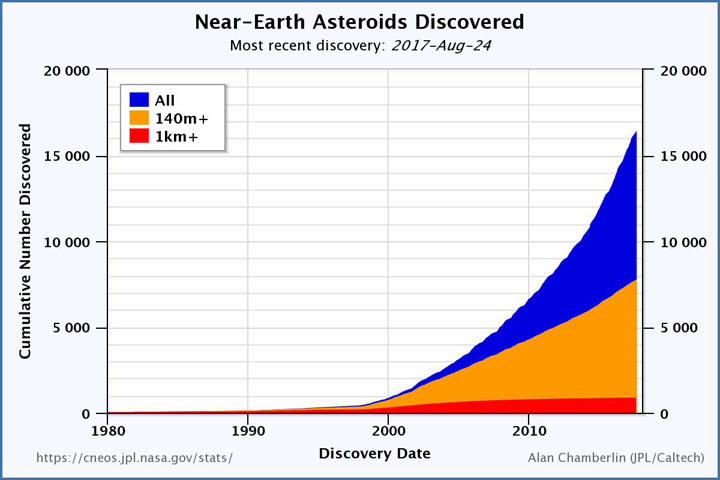
NASA / JPL / CNEOS
This is a rare opportunity to see what all the fuss is about when it comes to Earth-approaching asteroids. Not that 3122 Florence is expected to cross paths with the planet anytime soon, but this will be its closest approach since 1890 and the closest it will ever be until after 2500. That also makes it an alluring target for amateurs and ground-based radar observations, which are planned at NASA's Goldstone Solar System Radar in California and Arecibo Observatory in Puerto Rico.
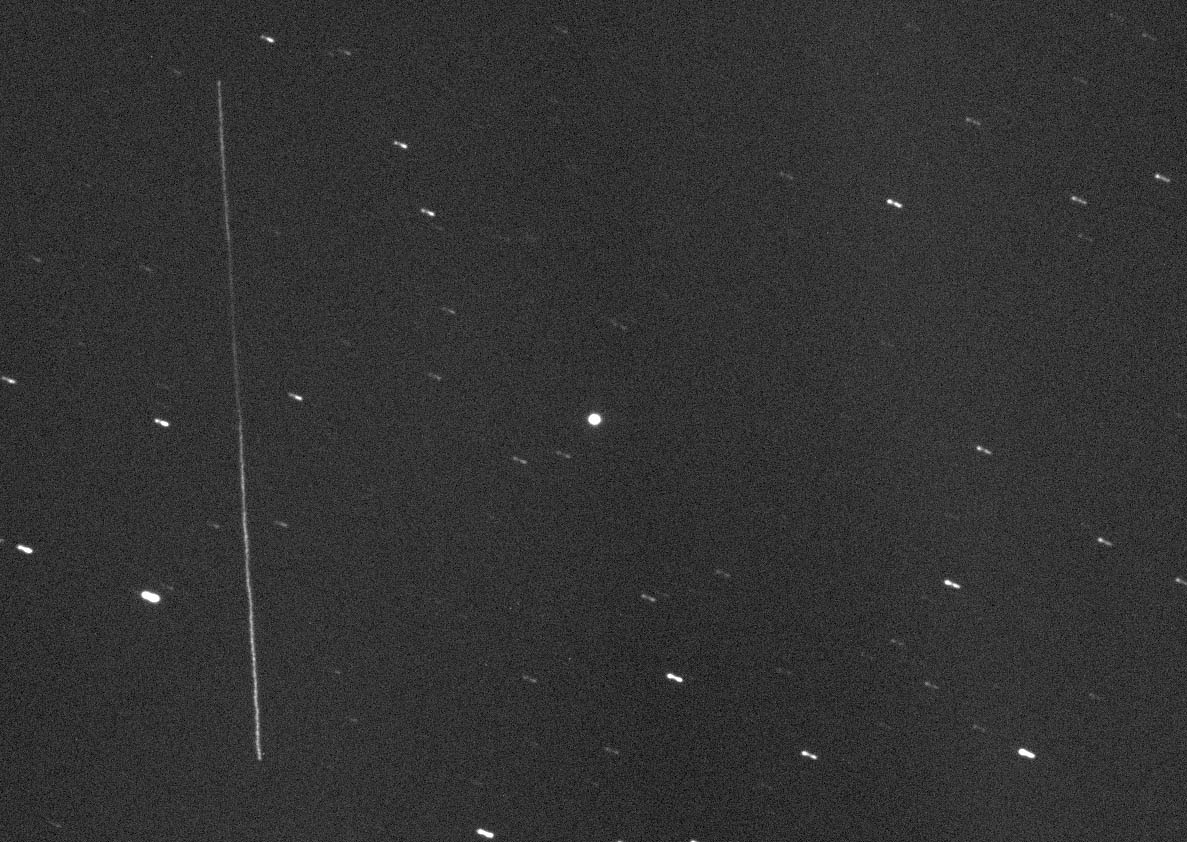
Gianluca Masi / Virtual Telescope Project
Imaging runs began on August 29th at Goldstone and will continue through September 8th, while those at Arecibo are scheduled from September 1st to the 5th. The radar images will pin down Florence's shape and size and could reveal details as small as about 30 feet (10 meters). Goldstone radar pix are already being uploaded to their website.
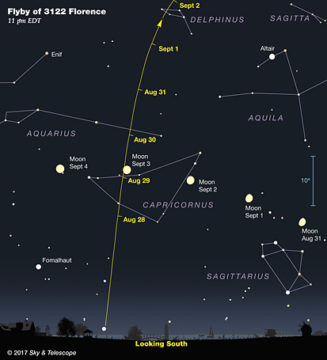
Florence swings northward from Capricornus across the nose of Delphinus and into the heart of Cygnus this week and next, making it an easy catch for observers across many latitudes. Its brightness and relatively fast (but not too fast) speed will quickly set it apart as traverses star fields at the rate of about 20 arcminutes an hour (20 arcseconds per minute) around the time of closest approach.
If you use a magnification of 150×-200× and the asteroid passes close to a star, you should be able to see it inch slowly along in real time.
Discovered by "Bobby" Bus in Siding Spring, Australia, in March 1981 and temporarily designated 1981 ET3, it's the 4th largest NEA after 53319 1999 JM8 (~7 km), 4183 Cuno (5.6 km), and 3200 Phaethon (5.1 km). Florence spins once every 2.36 hours during which time its brightness varies by 0.2 magnitudes.
Two-thirds of NEAs with this zippy of a rotation period have a satellite, but it's unknown if Florence does. According to Lance Benner, a research scientist at JPL who radar-images asteroids, if Florence does have a companion, chances are excellent they'll spot it with either the Goldstone or Arecibo antennas.
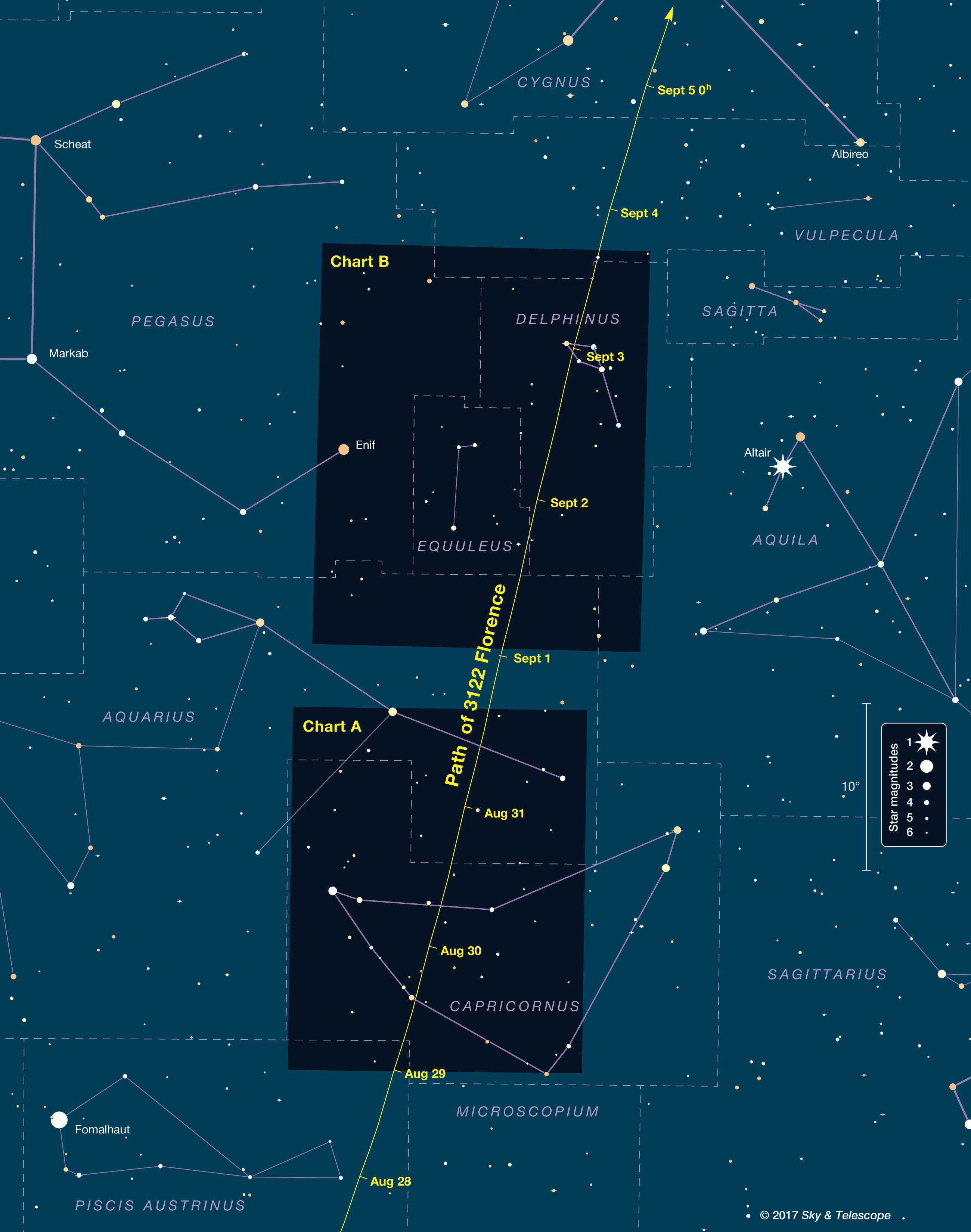
To find the asteroid, print out the appropriate chart, then interpolate between the marked positions for the time you plan to observe it. Set up your telescope with a low-power eyepiece and use the map to star-hop to the asteroid's position. Florence will be well placed for viewing starting about 9:30 p.m. local time.
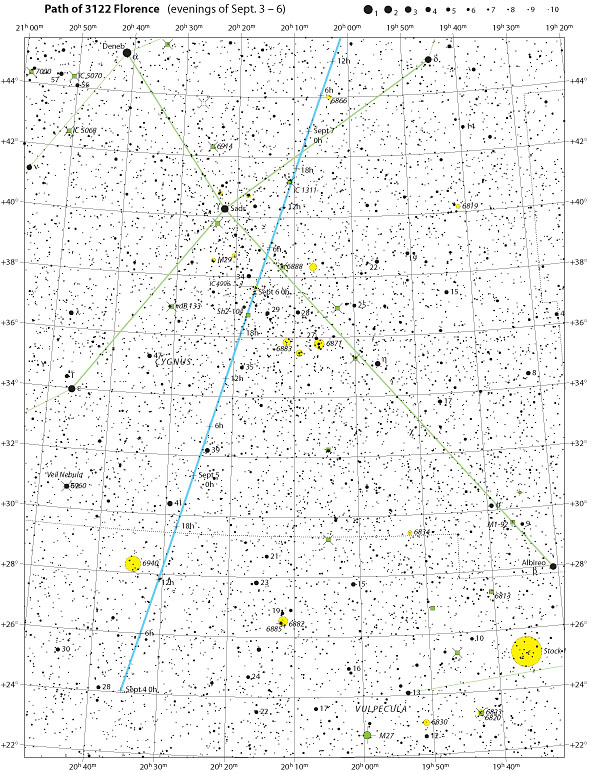
Even if you're hit with bad weather at closest approach, you'll probably still have a few nights left to join Florence for a ride-along. And if you're scope-less, you can watch the asteroid's travels in real time on Gianluca Masi's Virtual Telescope Project site on August 31st starting at 3:30 p.m. Eastern Daylight (19:30 UT). The Bareket Observatory in Israel will also webcast live views of Florence on September 1st from 3:00–6:00 p.m. Eastern Daylight (19:00–22:00 UT).
I can't wait. Good luck and happy hunting!
 29
29









Comments
stephen-limeburner
August 30, 2017 at 11:26 pm
Hello, Bob. I would guess that Florence does have a companion because tonight I took a few exposures of several minutes each and they all show a wiggly streak for Florence's path, despite pinpoint stars. ( I was not tracking the asteroid). I am surprised you say that no companion has been discovered because the path seems to follow a sine wave pattern with a period of about 2 minutes. That would seem to be a reasonable orbital period for a satellite of an object only 2.5 miles diameter.- Steve L. Cherry Springs Dark Sky Team, Coudersport, PA
You must be logged in to post a comment.
Bob KingPost Author
August 30, 2017 at 11:49 pm
Hi Stephen,
Thanks for writing. While it may be proven during this close approach that Florence has a companion, it is not yet confirmed. I wonder about your sine wave path. Could it possibly be periodic drive error? The reason I ask is that a 2-minute period for a companion would be much too fast. Orbital periods of binary companions are generally hours long.
You must be logged in to post a comment.
stephen-limeburner
August 31, 2017 at 11:04 am
I initially thought that it was periodic drive error but I became skeptical when I noticed and confirmed the locations of several known (pinpoint) stars in the field which I identified with my skymapping software. . I did notice the amplitude of the wave decrease later in the evening. I was not using an autoguider. I will try again tonight using a traditional SBIG CCD camera with autoguider. I would not be surprised if the "wave" disappears when I do so, but we'll see! Would you be interested in the images if I still record the "wave"?
You must be logged in to post a comment.
Bob KingPost Author
August 31, 2017 at 11:52 am
Hi Steve,
Excellent idea to check it out. Is there any way you could post a link to the image(s), so our readers could see it, too? I bet others would be interested.
You must be logged in to post a comment.
stephen-limeburner
September 1, 2017 at 10:08 am
Got one excellent image last night using Meade 8"LX200 Classic at f/10 and SBIG ST2000xcm CCD. It is a 15 minute color OSC exposure and clearly shows the wave pattern in the path of the asteroid. This does appear to be periodic error and guide corrections combined! Anyway, here is the link:
https://www.facebook.com/photo.php?fbid=1521568664575578&set=a.1324091427656637.1073741826.100001673788951&type=3&theater
You must be logged in to post a comment.
Bob KingPost Author
September 1, 2017 at 10:17 am
Stephen,
Thanks for sharing your photo -- that is some wiggle! I agree with your assessment.
You must be logged in to post a comment.
Frank-ReedNavigation.com
September 5, 2017 at 11:56 am
Minimum orbital periods around any object are the surface-skimming orbits, like LEO for the Earth. Orbital periods for moons/satellites range from a minimum of about 75 minutes when the primary body is very dense, like a solid iron asteroid, up to about 300 minutes for a low density object, like an icy comet with a lot of holes in it. The fun and fascinating element to this is that these numbers are entirely dependent on the density of the primary (the object that the moon or satellite is orbiting) and not affected at all by the primary's size. If you have a grain of sand orbiting a mini asteroid with a diameter of 10 meters and a density of 2.0 g/cm^3 (considered average for asteroids), that grain of sand will take about 146 minutes to complete an orbit. If we scale everything up by a factor of 10,000 so that the asteroid is now 100km across and the orbiting moonlet is 10 meters across, the orbital period for a surface-skimming orbit remains the same: 146 minutes. Size doesn't matter for moon orbital periods. Orbital periods of moons in surface-skimming orbits are approximately equal to (207 minutes)/sqrt(mean_density). But the range of mean densities for "solid objects" made of "normal matter" is relatively small, so that guarantees that orbital periods of low orbits are all about the same: almost always between 1.25 and four hours.
You must be logged in to post a comment.
Tom-Reiland
September 1, 2017 at 1:46 am
I made a questionable effort to go to Wagman Obs to try to spot the Asteroid Florence #3122 tonight. The combination of the bright Moon and scattered clouds made it difficult at first. There were some breaks in the clouds and I started what is probably my longest Starhop search using a telescope, the 21" Newtonian at Wagman Obs, in my 45 years of observing. It began at Altair and I slowly worked my way through Aquila, Delphinus, Equuleus into Aquarius until I was finally able to spot the NEO (Near Earth Object). I used the charts from Sky & Telescope and they were spot on! I watched it for at least 7 minutes to confirm my observation and I saw definite movement in relationship to several stars. This is at least the 8th NEO that I've been able to observe, maybe as many as 10. It's certainly one of the brightest at slightly brighter than 9 mag. Glad I made the effort because the forecast for the weekend isn't very good.
You must be logged in to post a comment.
Bob KingPost Author
September 1, 2017 at 10:24 am
Glad you spotted it, Tom. It's bright enough, so that once you see the asteroid, it's so easy to stay on its tail.
You must be logged in to post a comment.
Tom Hoffelder
September 3, 2017 at 10:12 am
Yes, and as you noted, far enough away that it stays in the field when tracking!
You must be logged in to post a comment.
cedric_pereira
September 1, 2017 at 5:04 am
Very good article about Florence. Last night, after read this article, I went outside try to capture the image of the asteroid... If you are interested, here is my capture:
https://flic.kr/p/Y1BvP7
https://www.youtube.com/watch?v=PZlbNl4l2i0
Greeting
You must be logged in to post a comment.
Bob KingPost Author
September 1, 2017 at 10:23 am
Hi Cedric,
That's a great video! Thanks for sharing it with our readers. I watched the asteroid last night, too. It was bright and easy to find; using 76x I could detect motion in just one minute. But when it approached a star closely, it moved, albeit slowly, in real time.
You must be logged in to post a comment.
Clark
September 1, 2017 at 8:31 am
It was a fun object to hunt down in an urban sky last night. I used binoculars and then a Dobsonian scope. Once the area was confirmed I figured it was one of three "stars" close to each other in the field of view . Sure enough the triangle they formed had a different configuration in 2 or 3 minutes. From then on it was easy to follow.
Thanks.
You must be logged in to post a comment.
Bob KingPost Author
September 1, 2017 at 5:23 pm
Clark,
Thanks for sharing your experience.
You must be logged in to post a comment.
Jim Hammond
September 1, 2017 at 4:22 pm
Here's about one hour of Florence moving through Aquarius on Wednesday night. https://youtu.be/6PVucpoIwik Kind of a bright moon at the start.
You must be logged in to post a comment.
Bob KingPost Author
September 1, 2017 at 5:28 pm
Jim,
That somewhat resembles its speed visually at high magnification. Nice work! For others checking out the video, the asteroid is located just below center and moves upward.
You must be logged in to post a comment.
Jim Hammond
September 1, 2017 at 5:52 pm
Thanks, Bob. We have a lot of smoke in the sky here in Central Oregon so my attempts tonight and tomorrow night may not be as successful as the moon will be pretty bright. Youtube degrades the image somewhat.
You must be logged in to post a comment.
Bob KingPost Author
September 1, 2017 at 7:07 pm
Jim,
Man or man, do I know about the smoke! Here in Duluth, last night began very clear (one of the few this summer as we've been plagued by Canadian forest fires), but an hour later, I watched the stars fade as a wave of fresh fire smoke eased back in.
You must be logged in to post a comment.
Jim Hammond
September 2, 2017 at 3:07 am
Well, I can't see any stars tonight. Maybe tomorrow night.
You must be logged in to post a comment.
Tom Hoffelder
September 2, 2017 at 10:05 am
Clear in South Paris/Norway Maine last evening for a public observing event where all attending had a grand time watching Florence change position among the stars from 8:30 to 9:30 in our 8 inch scope!
You must be logged in to post a comment.
AlfredCassis
September 2, 2017 at 1:01 pm
Nice 😀 (Y) Thanks for the pinpointing precisions 🙂 (Y)
You must be logged in to post a comment.
Bob KingPost Author
September 2, 2017 at 3:33 pm
Hey rocksnstars,
Sounds like a good time. Great idea for a public observing event. I may try that myself tonight.
You must be logged in to post a comment.
Fabrice Morat
September 3, 2017 at 9:46 pm
Hello Bob,
i've read your paper late and i observed Florence with success two hours ago (september 4th 0hTU) from La Palma island (Canary). The brightness of the gibbous moon was a little annoying for the star hopping but i fell on the right field thanks to your nice map. I used a T600 Dobson but i didn't switch on the servocat. The 100° of the Ethos (264x) was an help. Then, i went on at 353x. The apparent course of this bright asteroid was noticeable compared with other stars. The more interesting for me was its yellowish colour because i thought an asteroid was simply white ! I dont know about its own albedo. Have you notice such a hue in your observations ? Thanks for your fascinating news...
You must be logged in to post a comment.
Bob KingPost Author
September 3, 2017 at 10:20 pm
Dear Fabrice,
Thank you for sharing your observation, and I'm happy the extended map proved useful. You're the first to comment on the asteroid's color. For myself, I didn't notice any color but perhaps I wasn't paying close attention. I tried to find its B-V color index to see how "warm- or cool-toned" it might be but have been unable to track it down. Hopefully, others reading this will chime in with their color observations, if any.
You must be logged in to post a comment.
Tom-Reiland
September 4, 2017 at 5:20 am
I was able to get a second look at Florence tonight. Transparency was better, though the Moon was brighter than two nights ago. It was easier to find the region that the asteroid was passing through, though matching the correct triangle of stars it was moving by took a little more time because of the large number of stars between 8 and 10 mag. I estimated at 9.2 to 9.5 mag. I was able to show it to two other club members through the 21" at 127X at Wagman Obs. I did notice an error on the chart. Aquila is printed where Sagitta is located instead of on the bottom right corner section of the chart.
You must be logged in to post a comment.
Bob KingPost Author
September 4, 2017 at 9:28 am
Hi Tom,
Yes, that moon is filling out at the same time Florence is fading. I still hope to see it one last time in the 10 mag. range. Thanks for pointing the Aquila mislabeling. I appreciate it, and it's now corrected.
You must be logged in to post a comment.
James-Kirby
September 5, 2017 at 3:28 pm
Hi Bob,
After stacking 3 - 3min. exposures and zooming in on the resulting image, I was able to recognize a 5-arcmin long (broken) trail of Florence about 1 degree NW of 28 Vulpecula from 21:41 - 21:57 EDT on the evening of September 3rd with a 135 mm camera lens. The waxing gibbous moon combined with a bright urban sky in Pittsburgh made it difficult to confirm that I had set my camera on the correct region, at least until I reduced the data. Not a great quality image, but I was thrilled to capture my quarry!
You must be logged in to post a comment.
Bob KingPost Author
September 5, 2017 at 5:23 pm
James,
We all love that feeling as hunters of the sky 🙂
You must be logged in to post a comment.
Graham-Wolf
September 10, 2017 at 7:09 pm
It came....
I ducked......
It missed!
(Apologies to Julius Caesar).
Graham W. Wolf at 46 South, Dunedin, NZ
You must be logged in to post a comment.
You must be logged in to post a comment.